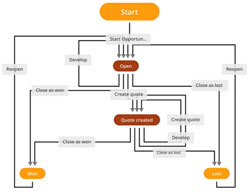 Yoav Kutner, CEO,ORO
Yoav Kutner, CEO,OROOverall Manufacturing Effectiveness (OME)
There are new metrics every manufacturer must consider for achieving best-practice efficiency. These metrics have moved beyond the plant floor. Whereas OEE (Overall Equipment Effectiveness) has been a calculation of optimize machinery output, the new standard, OME (Optimized Manufacturing Effectiveness) considers how to bring product to the B2B customer.
The technology solutions for OME start with a lower cost of ownership. Best-in-class solutions must include out-of-the-box features which reduce code-customizations, lowering maintenance costs.
Integration with third party applications is non-negotiable. The ability to simplify integration into existing business applications like ERP, Accounting, PIM, and other systems allow existing corporate data to be utilized and accessed without creating dysfunctional and disparate data.
Manufacturers are now required to optimize for both buyers and sellers, specifically accessible on any device. This requires that CRM and B2B eCommerce establish a single solution that sells products online and manages business operations.
Manufacturers measure how quickly product is MADE
without compromising quality…
B2B eCommerce manufacturers measure how quickly product is SOLD
without compromising quality.
Manufacturers insist on a shorter time to market which mandates getting an online store live rapidly and generating online sales immediately. This is only achieved with a powerful workflow engine which can digitize all seller and buyer-related business processes.
 The net result is a lower total cost of ownership and a shorter time to market resulting in a faster return on investment (ROI).
The net result is a lower total cost of ownership and a shorter time to market resulting in a faster return on investment (ROI).Request for workflow
OME is achieved when manufacturers can create simple workflows and treat RFQ's as opportunities. Often a buyer makes contact through the manufacturer’s website using an ‘Ask for Quote’ button and the information is automatically forwarded to the sales staff for response. Sales staff create a quote and develop it as a customer prospect.
Alternatively, a buyer may choose not to contact the manufacturer and instead go straight to the checkout with their shopping list full of items they picked online through a self-serve model. If they would like to negotiate the selected items for purchase, the "Request a Quote" option is available.
 Many industrial firms thoroughly detail the workflow, documenting the efficiency by adding complexity instructions which lay above the RFQ process.
Many industrial firms thoroughly detail the workflow, documenting the efficiency by adding complexity instructions which lay above the RFQ process.Benefits of workflow automation in B2B eCommerce
There are many reasons why manufacturers are automating the B2B eCommerce processes. The ability to enable data accuracy is paramount. Most eCommerce businesses generate an immense amount of new customer, inventory, or transactional data. When maintained by hand, these data might not get relayed when and where needed, leading to lost sales.
As data accumulates, it can get scattered or misplaced, putting further strain on operations. Workflow automation minimizes or outright eliminates human error. Businesses that automate manual tasks can perform them faster and with more precision. A single eCommerce rep must spend 30 minutes a day manually managing orders; automating this process will save them 130 hours of work over a year. This figure increases considerably once multiplied by 10 sales reps.
The OME result allows employees to spend more time on customer service, perform market research, competitor analysis, a/b testing, experimentation, and explore other creative business growth tactics. Workflow automation introduces elements of self-service. When customers can purchase, manage orders, and return without staff involvement, they save time and effort, improving customer retention.
The migration from B2C-focused eCommerce to dedicated B2B eCommerce
For those companies accustomed to B2C-focused eCommerce platforms from providers such as Magento and SAP, establishing a dedicated B2B eCommerce platform offers scalability, security, and other industrial-strength B2B features.
Armed with built-in CRM and robust API coverage to support PWA and Headless implementation, it is critical to easily integrate with manufacturers' internal enterprise tech stacks to work fluidly with existing ERP, product information management, and order management systems. Having a vibrant community of developers and open-source tools to support everything from self-service websites to fully featured B2B marketplaces are fundamental differentiators as the notion of digitization becomes ubiquitous.
|
Share this Article:
Tweet
|
Top





